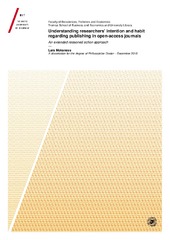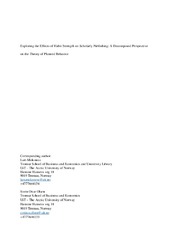| dc.contributor.advisor | Olsen, Svein Ottar | |
| dc.contributor.author | Moksness, Lars | |
| dc.date.accessioned | 2018-12-05T12:47:35Z | |
| dc.date.available | 2018-12-05T12:47:35Z | |
| dc.date.issued | 2018-12-13 | |
| dc.description.abstract | Scholarly publishing is the vessel for the dissemination of research articles. Contemporary scholarly publishing is achieved by two main models, open access (OA) and non-open access (non-OA). OA refers to articles that are available at no cost to the end-user; however, authors may incur a fee for accepted manuscripts. Non-OA articles are available at a cost, either via subscriptions or via individual downloads. Governments and funders are increasingly requiring research to be made openly available. This is causing friction in the research community, as the premise of OA is supported but not necessarily the practice. There are several reasons for this, and this dissertation provides four articles with the aim of improving the theoretical and empirical understanding of researchers’ intention and scholarly publishing behavior within an extended theory of planned behavior: a reasoned action approach. The general approach included testing the importance of the theory of planned behavior (TPB) constructs and identifying and developing belief dimensions and constructs pertaining to individual differences. The approach also included a discussion and test of how habit strength (using alternative models) relates to OA and non-OA publishing intentions and behavior. Articles 1 and 2 provided the starting point by investigating how individual differences in innovativeness and personality affect the precursors (e.g., attitudes, perceived quality, and trust) of publishing intentions in a small sample of researchers. Articles 3 and 4 furthered the knowledge obtained in the previous articles and examined factors such as perceived quality and habit strength. The fourth article also assessed the effects of habit strength on both OA and non-OA publishing behavior. | en_US |
| dc.description.doctoraltype | ph.d. | en_US |
| dc.description.popularabstract | Publishing research articles is achieved by submitting a manuscript to a peer-reviewed scientific journal. Specialists will then evaluate the content and quality of the manuscript and make a recommendation whether the journal should accept the manuscript and publish it, or reject it. Typically, the published article will be available at a cost, either a download cost or through a subscription. A second option shifts the cost of publishing to the researcher, which allows the article to be freely available to anyone who wishes to read it. This is called open access, or OA. An argument in favor of this method is that research which is conducted at universities is funded by public money. In short this means that the articles produced from this research should be freely available as well.
Open access is relatively new and made possible by the internet and digital media. For various reasons this method of publishing has met resistance among researchers, even though it arguably is a more democratic way of enabling access to research articles. The question why researchers choose one publishing method over another has been frequently researched over the years. Few studies have, however, used attitudinal and behavioral theories to investigate the role such theories play in explaining, measuring, and predicting publishing behavior. The purpose of this dissertation was to provide a theory-driven approach and analysis procedures that would contribute to this research stream.
The four articles in this dissertation employed web-based surveys as the main method for data collection. The first survey was conducted at UiT – The Arctic University of Norway, and the second was a national survey. Researchers who had published or were going to publish scholarly articles answered the surveys. In the first article, the purpose was to understand how attitudes, norms, and perceptions of control influence the intention to publish with open access. The model also included a variable that considered how a person’s inclination towards using technology affects attitudes and perceptions of control. The results showed that attitudes contribute the most to intentions, followed by norms and behavioral control. All the factors influence intentions positively apart from perceptions of autonomy, which has a negative effect. Innovativeness was found to increase attitudes and reduce perceptions of autonomy.
The purpose of the second article was to learn how the personality traits agreeableness and conscientiousness influence trust and perceived quality and how these factors subsequently influence the intention to publish research articles via OA or non-OA channels. The main findings are that trust increases the intention to publish via OA and decreases the non-OA intention. Perceived quality has a positive influence on the intention to publish via non-OA and reduces the intention to publish via OA.
In the third article, the aim was to understand whether and how two factors of self-identity (career- and work self) and three perceived quality factors influence the intention to publish in OA or non-OA journals. The study found that perceived impact quality increases the intention to publish through non-OA while decreasing the intention to publish through OA. Content quality is only associated with non-OA journals. Perceived visibility increases the intention to publish with OA, and the opposite effect was found for non-OA. Career self has the strongest effect on the impact quality, and work self contributes more to the content quality.
The intention of the fourth article was to explore alternative models of habit strength from the theory of planned behavior perspective (TPB) in the context of OA and non-OA publishing. Some of the findings are that OA habit strength reduces the intention to publish in non-OA journals and non-OA publishing behavior. Descriptive norms were also found to contribute to habit strength over and above attitudes.
This study suggests that institutions can encourage OA publishing by expanding on the way in which information campaigns and presentations are run. Attitudes are important in this context; however, researchers operate within a social context as well, emphasizing the importance of normative influences. Norms are found to increase habit strength, and perceptions of quality are likely to be affected substantially by norms as well. For instance, the results from the national study show that perceived visibility is positively associated with OA but not perceived content quality and status. The latter two are only affiliated with non-OA. Efforts should therefore be made to unify the publishing models under the banner of scholarly dissemination in both daily and professional discourse. Strategies could also benefit from addressing publishing habits by exposing researchers to viable OA options for their research. Care should be taken not only to provide researchers with information about OA and OS on demand but to run recurring events with question and answer (Q and A) sessions at faculties and institutes. Recurring events will increase the probability that behavioral change interventions will be successful, particularly if habits are involved. | en_US |
| dc.identifier.isbn | 978-82-8266-162-1 | |
| dc.identifier.uri | https://hdl.handle.net/10037/14289 | |
| dc.language.iso | eng | en_US |
| dc.publisher | UiT The Arctic University of Norway | en_US |
| dc.publisher | UiT Norges arktiske universitet | en_US |
| dc.relation.haspart | <p>Paper I: Moksness, L. & Olsen, S.O. (2017). Understanding researchers’ intention to publish in open access journals. <i>Journal of Documentation</i>, 73(6), 1149–1166. Full text not available in Munin due to publisher restrictions. Published version available at <a href=https://doi.org/10.1108/JD-02-2017-0019>https://doi.org/10.1108/JD-02-2017-0019. </a>Accepted manuscript version available at <a href=http://hdl.handle.net/10037/11662>http://hdl.handle.net/10037/11662. </a><p>
<p>Paper II: Moksness, L. & Olsen, S.O. (2018). Trust versus perceived quality in scholarly publishing: A personality–attitude–intention approach. <i>College & Research Libraries</i>, 79(5), 671–684. Also available at <a href= http://hdl.handle.net/10037/12449>http://hdl.handle.net/10037/12449. </a><p>
<p>Paper III: Moksness, L. & Olsen, S.O. (2018). Perceived quality and self-identity in scholarly publishing. (Submitted manuscript). <p>
<p>Paper IV: Moksness, L. & Olsen, S.O. (2018). Exploring the effects of habit strength on scholarly publishing: A decomposed theory of planned behavior. (Submitted manuscript).<p> | en_US |
| dc.rights.accessRights | openAccess | en_US |
| dc.rights.holder | Copyright 2018 The Author(s) | |
| dc.rights.uri | https://creativecommons.org/licenses/by-nc-sa/3.0 | en_US |
| dc.rights | Attribution-NonCommercial-ShareAlike 3.0 Unported (CC BY-NC-SA 3.0) | en_US |
| dc.subject | VDP::Samfunnsvitenskap: 200::Psykologi: 260::Andre psykologiske fag: 279 | en_US |
| dc.subject | VDP::Social science: 200::Psychology: 260::Other psychology disciplines: 279 | en_US |
| dc.subject | VDP::Samfunnsvitenskap: 200::Biblioteks- og informasjonsvitenskap: 320::Informasjonspolitikk: 322 | en_US |
| dc.subject | VDP::Social science: 200::Library and information science: 320::Information politics: 322 | en_US |
| dc.title | Understanding researchers’ intention and habit regarding publishing in open access journals | en_US |
| dc.type | Doctoral thesis | en_US |
| dc.type | Doktorgradsavhandling | en_US |


 English
English norsk
norsk



